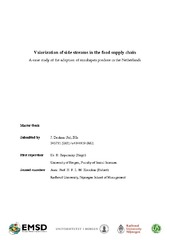Valorization of side streams in the food supply chain: A case study of the adoption of misshapen produce in the Netherlands
Master thesis
Permanent lenke
https://hdl.handle.net/1956/16704Utgivelsesdato
2017-08-23Metadata
Vis full innførselSamlinger
- Department of Geography [634]
Sammendrag
In a context of increasing food insecurity, this thesis introduces a case study that evaluates adoption of misshapen produce by consumers as act to counteract food wastage. Apart from some separate events that report financial benefits, there is little known about what exactly drives adoption of misshapen fruits and vegetables and whether food waste is actually reduced. The potential of this type of valorization of side streams in the food supply chain as business model is assessed by investigating the interplay between human agents and social structures in the social practice of adoption. This interplay is represented in a system dynamics simulation model that is developed and calibrated based on a triangulation of literature, interviews, and observations. In this model, the wide variety of factors that are considered to influence adoption of misshapen produce boil down to a few causal structures that explain the majority of its development. These causal structures connect an acceptance dynamics framework with a supply chain model of vegetable production in the Netherlands. The model is used for testing (combinations of) policies aimed at subsidizing prices, generating food wastage awareness, creating motivation, and developing skills in relation to misshapen produce. It is found that a major constraint in the adoption potential of misshapen produce is the limited supply of misshapen produce, which is a fraction of total fruits and vegetables production. Policy tests over different scenarios in the Dutch food supply chain indicate that the implementation of a subsidy plan for partially reimbursing the price consumers pay for acquiring misshapen produce and the price farmers receive for supplying misshapen produce in combination with a nationwide marketing campaign for generating food wastage awareness uses the full (constrained) adoption potential of misshapen produce. An interesting finding, however, is that adoption of misshapen produce does not reduce food wastage in the food supply chain. Based on the findings from this exploratory research, many directions for further research are given for further exploration of misshapen produce as viable business model and for further development of the concept of adoption dynamics.
